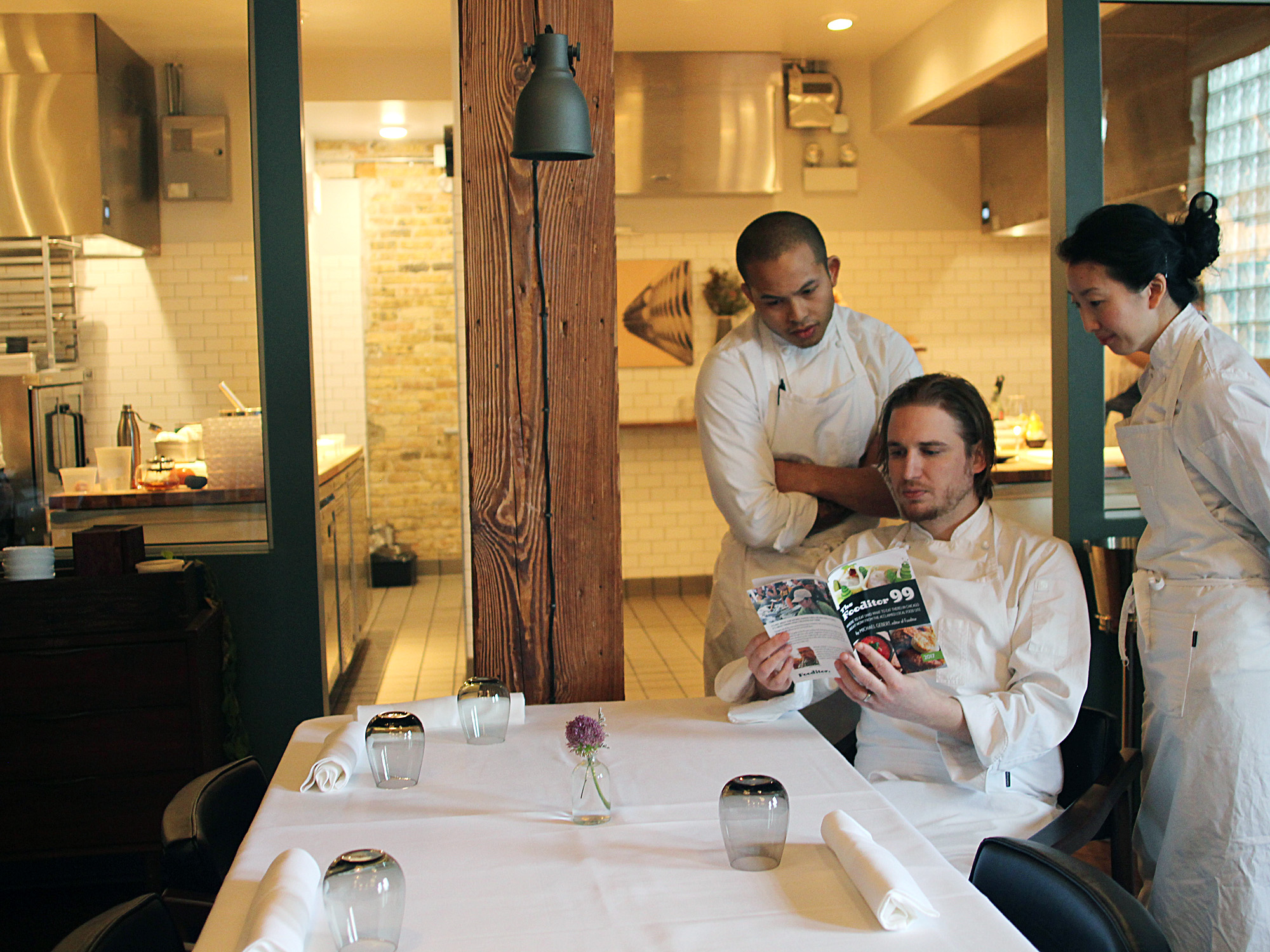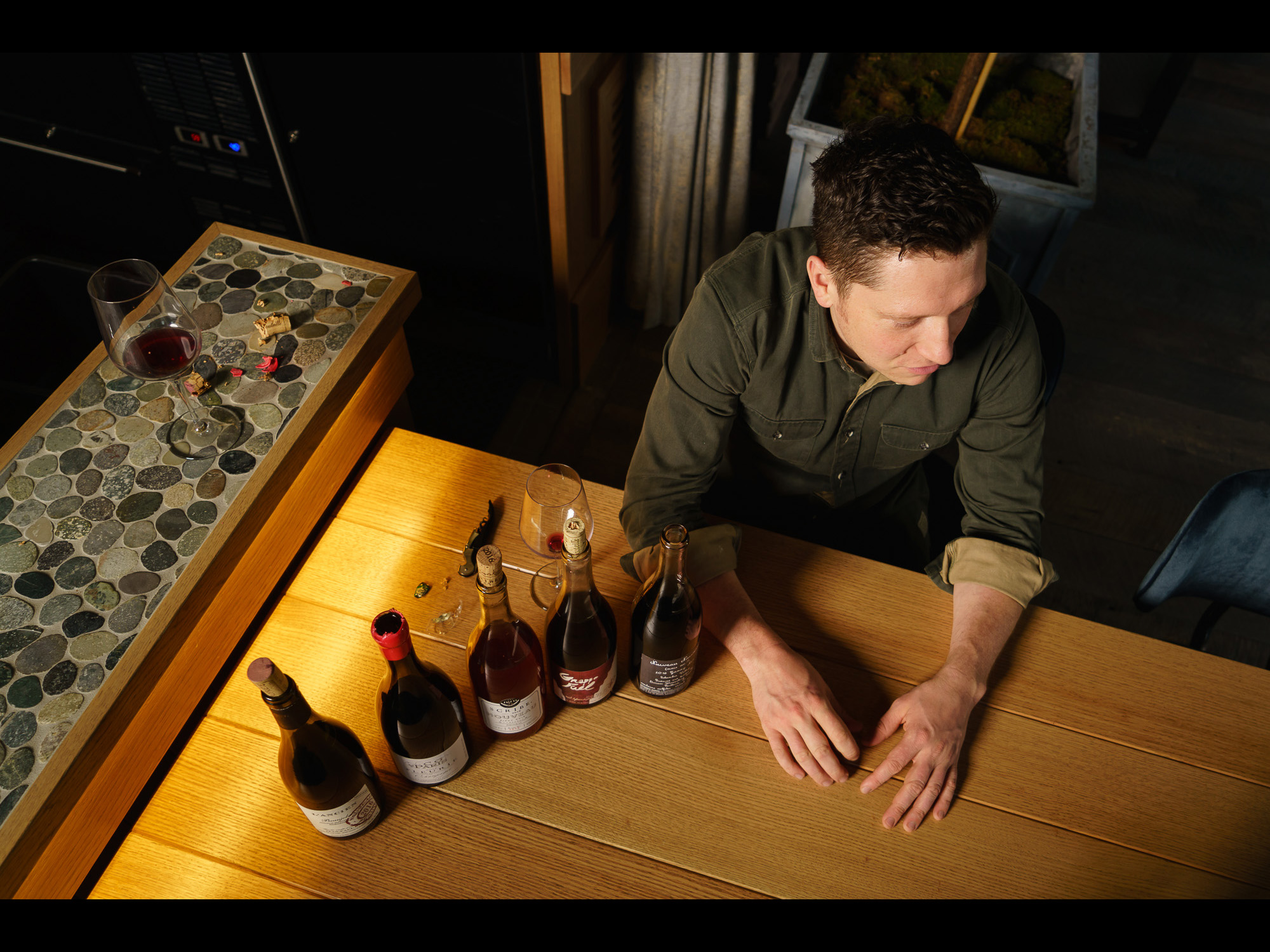REQUEST A CURTSY AND A BOW ($20) at Baptiste & Bottle in the new Conrad Chicago hotel, and you’ll get a whole show—inspired by the glassware beverage manager Michael Fawthrop chose for the cocktail, one of two prepared on a tableside cart at the bourbon-centric restaurant and bar. The bottom vessel, which looks like a small beaker, holds fog created by putting a tonka bean in hot water and dry ice, while the top contains a blend of Basil Hayden 8-year bourbon, Orgeat, and absinthe. Nestled together, the two glasses might remind you of something familiar: a miniature Chemex coffeemaker.
That’s because they actually are a Chemex creamer and sugar caddy. “We originally were going to have Chemex coffee service for the hotel, but then we decided just to offer American black coffee, so I had all these sugar bowls and creamers and wanted to figure out something to do with them,” Fawthrop explains. “I thought they’d be great for a fog drink.”
Baptiste & Bottle is one of a growing number of places that are paying as much attention to drink presentation as to the drinks themselves. They range from trendy cocktail spots, such as The Sixth, to retro tiki bars like Lost Lake and include lounges built around a concept, such as Arbella, a celebration of global travel. Each has a distinctive style and different sources, but all distinguish themselves from the competition and captivate guests with their creativity.
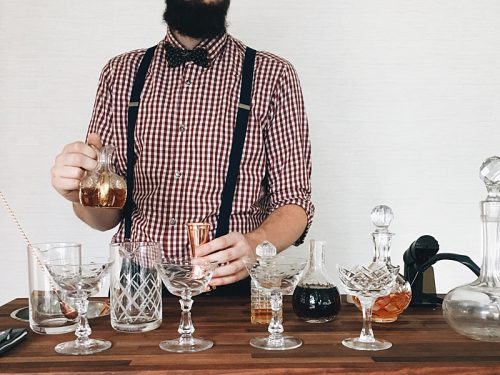 Erica Eckman
Erica Eckman Drink cart at Baptiste & Bottle
FAWTHROP SAYS THAT BAPTISTE & BOTTLE, which opened in mid-November, has spent about $12,000 on glassware so far. He has 18 different glasses for a dozen-plus cocktails and more than 75 different bourbons and other spirits. While flights of whiskeys are served neat in distinctively shaped Glencairn glasses from the U.K., his other suppliers include Degenne Paris, which has an outpost in New Jersey, as well as estate sales, auctions, and antiques shops.
“I like to have about 60% vintage glassware to 40% new,” says Fawthrop. “I think the old glass fits our style better, and lots of it is etched, which I really love.” He adds that he tries to go to estate sales and auctions at least twice a quarter, as well as checking out web sites like EstateSale.com.
A couple of Fawthrop’s favorite finds are the set of 12 13-ounce highball glasses he got at a South Side auction for $4 each (they look like they’re broken but they’re not) and an antique decanter with a lock on it purchased on Ebay for $30 that’s on the tableside cart. He also prizes a 27-piece glass set with two beautiful pitchers, especially since complete antique sets are rare. “Lot sizes have varied from 18 to 200 glasses,” he estimates, “and you have to take advantage of opportunities when they arise.”
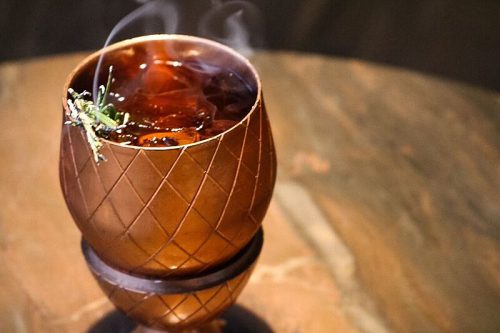 Kailley Lindman
Kailley Lindman Southside Mule in pineapple cup
The other drink currently made on the tableside cart is The Huntsman ($20). The combination of Glenfiddich 14-year Scotch, Punt e Mes Italian vermouth, and Giffard apricot liqueur is smoked with Angostura Bitters and rooibos (African red tea) in a vintage decanter, then poured into a wide-mouth antique martini glass. “It’s meant to conjure up hunting on an estate in Scotland,” Fawthrop says, “and the glass really lets you smell the rooibos smoke.”
Regular drinks include the Southside Mule ($13), a variation on the Moscow Mule that comes in a Pineapple Co. copper pineapple (rather than the usual copper mug) garnished with pineapple-rosemary shrub, and a Rootbeer Fizz ($13) featuring Averna Amaro in a crystal highball glass that’s etched on the bottom and accompanied by a matching bowl of the smoked salt used to bring out the aromas of the root beer. There’s also the “place your bet on the dealer” option allowing patrons to choose their spirit and range of flavors. “We really need a lot of eclectic glassware to pull this off,” Fawthrop says. “Cocktails taste different in different glasses, and having a large variety enables us to enhance our guests’ experiences.”
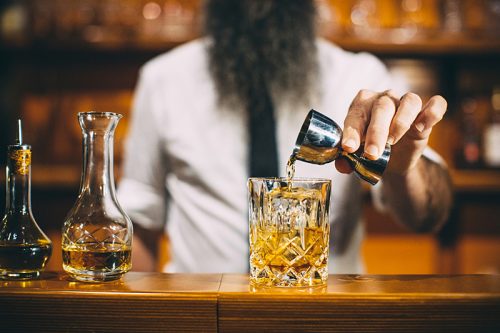 Clayton Hauck
Clayton Hauck The Milk Room
VIRTUALLY ALL OF THE GLASSWARE IS VINTAGE at The Milk Room, the tiny eight-stool bar in the Chicago Athletic Association Hotel. Paul McGee, beverage director for Land and Sea Dept., which runs the bar, says he has about 20 different vintage glasses for the eight frequently changing cocktails and the tasting portions of rare spirits. He sometimes changes the glass for a specific drink, depending on what’s on hand and what breaks. “The fun is having to re-up glassware all the time,” he says, estimating that he spends $700 to $800 annually and loses about 25 percent of the glasses to breakage.
McGee buys much of his glassware from an antiques store in Pilsen that he declines to name, but also shops at vintage stores all over. “I look for glasses from the 1920s and ’30s,” he says, “and usually find four at a time, though if there are more, I’ll snap them up.” He has double Old Fashioned crystal glasses on hand because customers gravitate towards that style of cocktail, but a glass he likes best is a 4-ounce one with a slightly tapered bottom and gold ornamentation that he found in a Louisville antiques shop. “It’s perfect for a cocktail like a Sazerac, and I bought all four for $10 each,” he says. “But now I’m down to one and searching for more.”
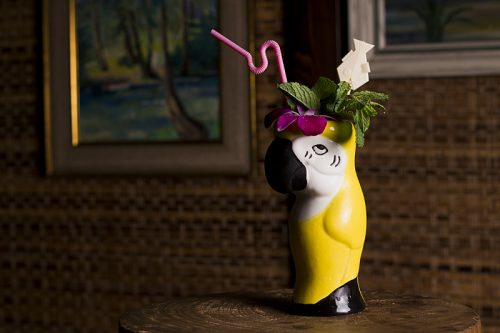 Shelby Allison
Shelby Allison Heaven Is a Place, This Is the Place, Lost Lake
A partner in Land and Sea Dept.’s Lost Lake in Logan Square, McGee develops his drinks before deciding what to put them in. Fanciful ceramic mugs—elaborately garnished with fruit, flowers, swizzle sticks, and such—are the rule at the tiki bar, and he says the size and color of the cocktails help determine the containers. “We’re inspired by Don the Beachcomber restaurants of the 1930s, rather than 1950s and ’60s tiki bars, and many of our mugs have a nautical theme,” he explains. “Our customers respond very favorably to the immersive escapist package.”
McGee spends about $5,000 a year on mugs and loses about 10 percent of them to breakage. Most are available online and from West Coast tiki mug specialists, though a couple of larger items, such as the conch shell for the shared Fogcutter ($50)–London Dry Gin, aged Demerara Rum, Cognac, Sherry, lime, Orgeat, Cucaçao, Angostura Bitters—are from a company in London. The Bourbon Barrel ($30), a shared drink of aged rum and bourbon with pineapple and lots of other ingredients, comes in a pineapple, but rather then the usual copper, McGee’s is a food-safe ceramic vase originally meant for flowers. Smaller mugs are shaped like parrots, seahorses, fish, a coconut shell, even a skull.
 Shelby Allison
Shelby Allison The Bourbon Barrel, Lost Lake
One of the mugs McGee loves the most is a little rum barrel custom made by Chicago artist Joseph Craft and for sale in turquoise or pink.”The barrel is meant as a traditional take-home memento of the tiki bar experience rather than being used on the meu, but if someone buys one and wants us to put a drink in it, we will,” McGee says.
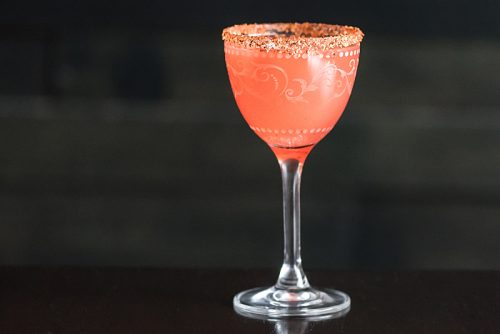 Kailley Lindman
Kailley Lindman Funky Chicken, Arbella
PRESENTATION IS SO IMPORTANT AT ARBELLA, the River North lounge opened in May by the team behind Tanta Peruvian restaurant, that the menu even has little pictures of the glasses next to the descriptions of the two-dozen-or-so international cocktails. “That was co-owner Brian DeNicolo’s idea,” says general manager and beverage director, Diego Pilares. “Some people don’t like the glassware they get, so we wanted to give them an idea in advance of what it would be.”
Arbella uses eight to ten different glasses from a variety of sources that ranges from large suppliers, such as Libbey Glassware and Steelite International, to online merchants, Amazon, and little shops around town. Besides an initial investment of $3,000, the budget is about $200 a month, which is roughly the loss due to breakage. A small martini glass called a “Nick and Nora” for the lead characters in “The Thin Man” movies is standard for about half of the cocktails, almost all of which are developed before the glassware is chosen.
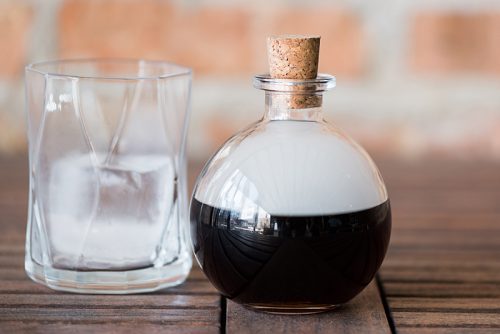 Kailley Lindman
Kailley Lindman Chicago Fire Extinguisher
The exception is the Chicago Fire Extinguisher ($15), a combination of Scotch, Luxardo Amaro Abano, and smoked Angostura Bitters inspired by a globe-shaped bottle found on SpecialtyBottle.com by co-owner J. P. Bitting. “We wanted a cocktail that was unique to Chicago, and he pointed out that this cork-topped bottle resembles the glass containers filled with saline solution that used to be hung around places of business, ready to be thrown at a fire to keep it from spreading,” Pilares says. Designed to suggest the aftermath of a fire (as in the Great Chicago Fire), the drink is mixed in the bottle, then a fan pushes smoke from smoldering wine-barrel wood chips into the bottle via tube. When the server opens it to pour half the cocktail into a beveled Old Fashioned glass with a big chunk of crystal clear ice from the Clinebell ice block machine, the smoke pours out.
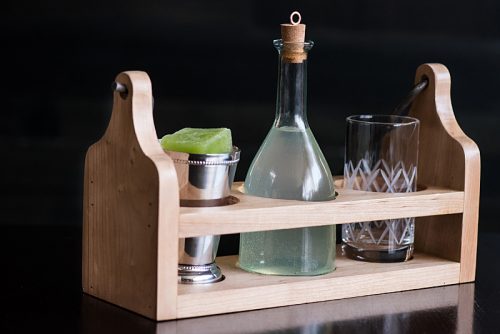 Kailley Lindman
Kailley Lindman Bottle service Chilcano, Arbella
Arbella’s other unusual cocktail is the Chilcano ($13), a takeoff on traditional Peruvian bottle service. Instead of getting a bottle of Pisco, ginger ale, bitters, etc. to assemble the drink themselves, customers are presented with a custom-crafted wooden tray holding cucumber-infused Pisco in a handsome decanter flanked by glassware and the other ingredients. “We wanted to keep the interaction but do all the work for you,” Pilares says.
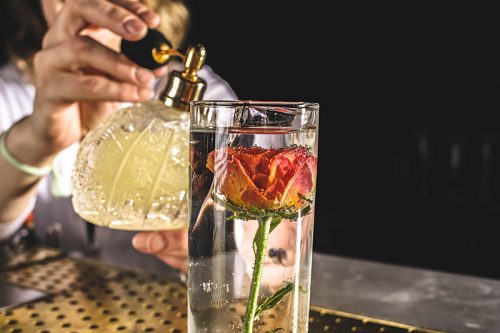 Ethan Talley
Ethan Talley The Doris, The Sixth
ONE OF THE MOST POPULAR COCKTAIL BARS in town is Lincoln Square’s The Sixth, opened by The Fifty/50 Restaurant Group in late 2015. Beverage director Benjamin Schiller, who says he spends close to $500 a month on glassware and other vessels, about a quarter of them vintage, not only shops everywhere from antiques stores to specialty sites like ThinkGeek.com, he also says friends who know what he likes scour the countryside for him, and even people he doesn’t know—like those who see pictures of his cocktails on social media—bring him stuff all the time.
In Schiller’s case, the containers often inspire the frequently playful drinks on the menu, which changes more-or-less seasonally. A glass dish for caviar service from a standard restaurant supply house spawned Spaceman Spiff ($12), named for one of Calvin’s alter egos in the “Calvin & Hobbes” comic strip. When the top part, which looks like a stemless martini glass and holds the mezcal-based drink, is lifted, the cedar and citrus smoke in the bottom dissipates, revealing a fake aquarium scene from a world Spiff visited. “The minute I saw the dish, I knew we could put something other than crushed ice (to keep caviar chilled) in the bottom, and the concept evolved from there,” Schiller says.
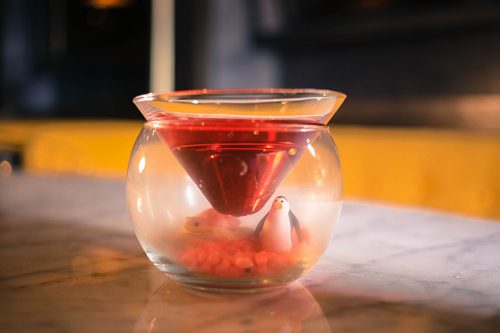 Ethan Talley
Ethan Talley Spaceman Spiff, The Sixth
Other nods to pop culture include the Bracer ($12), a rye, stone pine, amaro, and porter paean to “Game of Thrones” and Eddard Stark, that’s strong enough to hold up to the ox horn mug from Alehorn that holds it, and Sarlacc Pit ($12), a rum drink in a Boba Fett “Star Wars” tiki mug with, instead of the usual grapefruit-based “Don’s Mix,” what he calls “Han’s Mix” of orange and half-a-dozen spices. “At least once a week, someone who has seen the Sarlacc Pit on Instagram or Facebook comes in and asks to buy the mug,” says Schiller, adding that he’s down to 25 of them.
Schiller also has copper and bronze pineapples from a specialty housewares store that he used in summer for the Saturnus, an aquavit variation on a tiki classic garnished with a Swedish flag and Swedish fish candy. They now cradle the Gardener’s Gift ($12), a blend of mezcal, aperol, pineapple, and lemon.
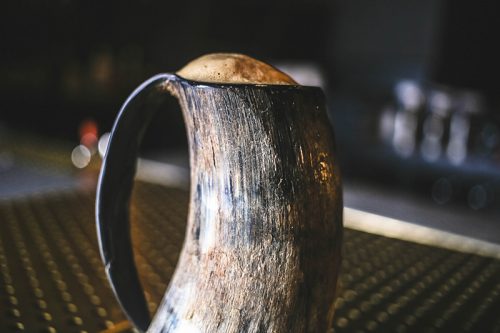 Ethan Talley
Ethan Talley The Bracer, The Sixth
The Doris ($12), a gin-forward drink named for his grandmother that’s off the menu but likely to make a comeback, features a rose encased in an ice cube in the Collins glass and a flower water garnish sprayed from an antique perfume sprayer. The Sixth’s signature, the Silly Rabbit ($12), is a tribute to the children’s cereal Trix in three parts; a tall wine carafe of gin and lemon (a take on the Southside) that’s poured over a Collins glass with two straws and a stack of technicolor fruit-flavored ice cubes (orange, lemon, raspberry, grape). They release juicy flavors as they melt, and you also get a tiny dropper bottle of bitters to balance the sweetness—because, after all, this is for grownups.
Schiller says he gets as much positive feedback on the presentations and glassware as on the flavors. “That inspires me to keep searching for more,” he says. His latest quest: hollow-stemmed Champagne coupes for the Vermeer. They are as fragile as they are beautiful, and all of his have broken.
Anne Spiselman is a freelance writer who has covered food, wine, and culture for decades. She’s a frequent contributor to Crain’s Chicago Business and Edible Chicago and has written for most local publications and some national ones.
COVER IMAGE: Erika Eckman for Baptiste & Bottle
Latest
Join the Discussion
After you comment, click Post. If you're not already logged in you will be asked to log in or register with Disqus.





